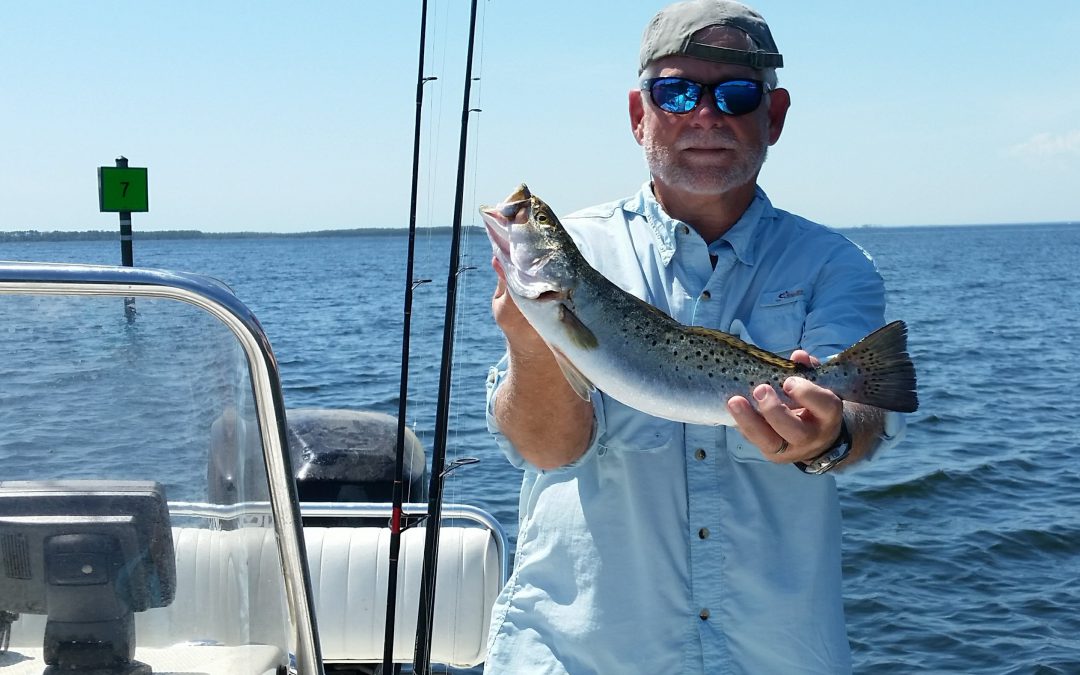
by Mark Mauldin | Feb 28, 2020
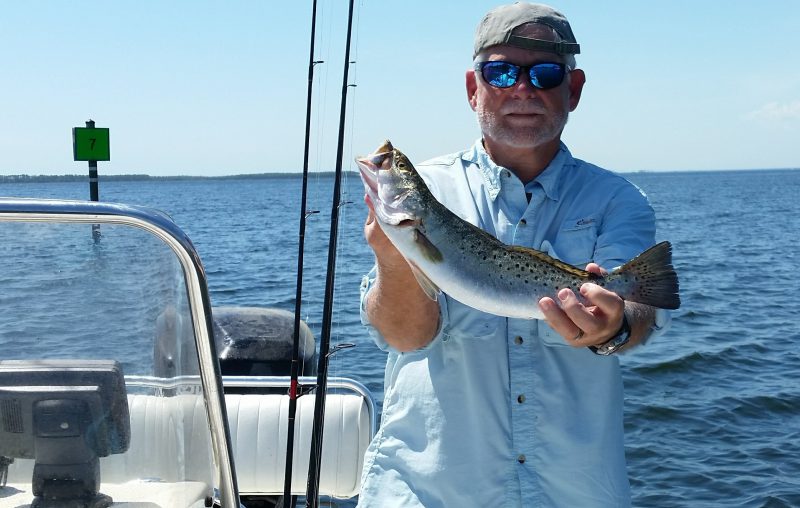
A spotted seatrout caught last summer in the St. Andrew’s Bay system (an area now included in the new Western Panhandle Management Zone).
Photo credit: Mark Mauldin
Recently FWC (Florida Fish & Wildlife Conservation Commission) announced rule changes relating to spotted seatrout.
The text was taken directly from FWC press releases; details not pertinent to NW Florida were removed.
Several rule changes for spotted seatrout [went] into effect Feb. 1, including a closure to spotted seatrout harvest in the new Western Panhandle management zone. Spotted seatrout are one of Florida’s most popular inshore fisheries. The Florida Fish and Wildlife Conservation Commission (FWC) made these changes after reviewing the results of a recent stock assessment and gathering input from anglers. These changes were made to benefit spotted seatrout populations while continuing to provide quality fishing opportunities.
The following rules [went] into effect Feb. 1, 2020:
- Creating two new zones by splitting the Northwest spotted seatrout management zone into the: (See maps below.)
- Western Panhandle (Escambia County through the portions of Gulf County west of longitude 85 degrees, 13.76 minutes but NOT including Indian Pass/Indian Lagoon).
- Big Bend (remaining portion of Gulf County plus Indian Lagoon, and Franklin County through Fred Howard Park Causeway in Pinellas County).
- Reducing bag limits
- Western Panhandle: three fish (was five).
- Big Bend: five fish (no change).
- Modifying the recreational slot size limit from 15-to-20 inches to 15-to-19 inches total length.
- Allowing one seatrout over 19 inches per vessel (currently per harvester).
- Prohibiting captain and crew from keeping a bag limit on a for-hire trip.
- Re-establishing the February recreational closure in the Western Panhandle zone.
Learn more about spotted seatrout by visiting MyFWC.com/Marine and clicking on “Recreational Regulations” and “Spotted Seatrout.”
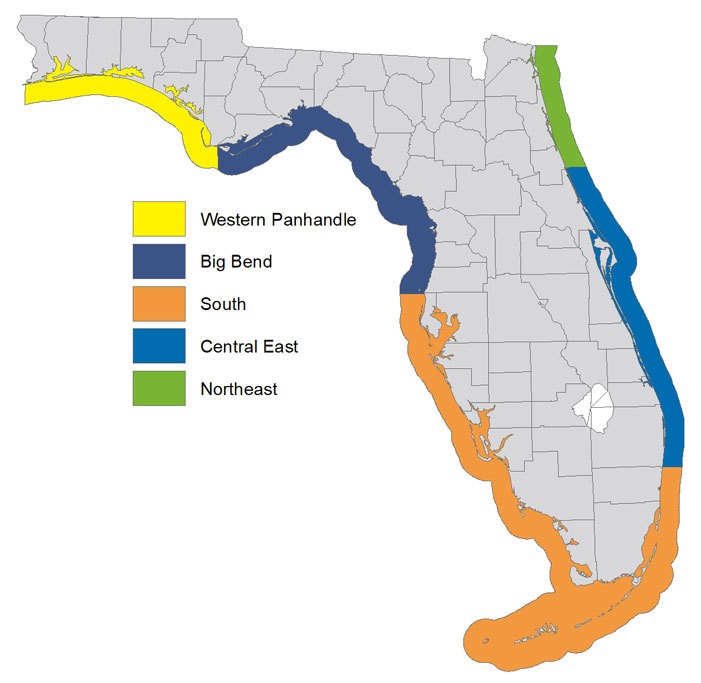
Newly-approved FWC Spotted seatraout management zones, effective February 1, 2020
Image source: www.myfwc.com
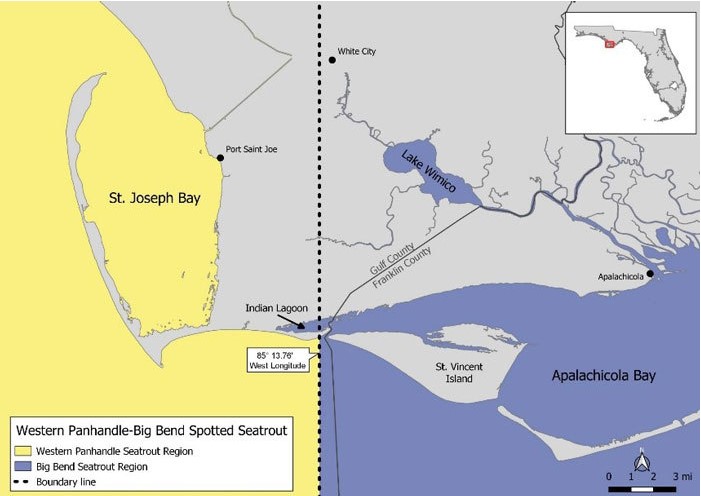
New boundary between the Western Panhandle and Big Bend spotted seatrout management zones effective Feb. 1, 2020.
Image source: www.myfwc.com
Earlier this week Governor DeSantis announced the dates for the 2020 Gulf Red Snapper Season – June 11 through July 25.
Governor Ron DeSantis Announces 2020 Gulf Red Snapper Season
Tallahassee, Fla. – Today, Governor Ron DeSantis announced the popular 2020 Gulf red snapper recreational season is set to open June 11 through July 25, with a possible fall reopening if quota is available. This season will apply to those fishing from private recreational vessels in Gulf state and federal waters, and to charter vessels that do not have a federal reef fish permit and are limited to fishing in state waters only.
Earlier this month, Florida was delegated authority to manage recreational red snapper harvest from private vessels in Gulf federal waters.
“I’m pleased to announce that our state’s good conservation practices are allowing us to have a 45-day Gulf red snapper season this year,” said Governor DeSantis. “Gulf red snapper season is always an exciting time for anglers and is just another reason why Florida remains the Fishing Capital of the World.”
“Gulf red snapper is a conservation and management success story for Florida anglers,” said Florida Fish and Wildlife Conservation Commission (FWC) chairman Robert Spottswood. “Just a few years ago, a 45-day season for red snapper in both state and federal waters was out of reach. Thank you to all the stakeholders and anglers who helped make this season possible by providing input and sharing information about their fishing trips.”
“FWC is proud to be able to work with our stakeholders to balance conservation with fishing opportunities for Gulf red snapper and we are excited to see what the future holds as FWC takes the unprecedented step of managing this resource in both state and federal waters of the Gulf,” said Spottswood.
For more on recreational snapper regulations, visit MyFWC.com/Marine and click on “Recreational Regulations” and “Snapper” under the “Reef Fish” tab.
Follow the link for more information on Snapper fishing in Florida – FWC Snappers
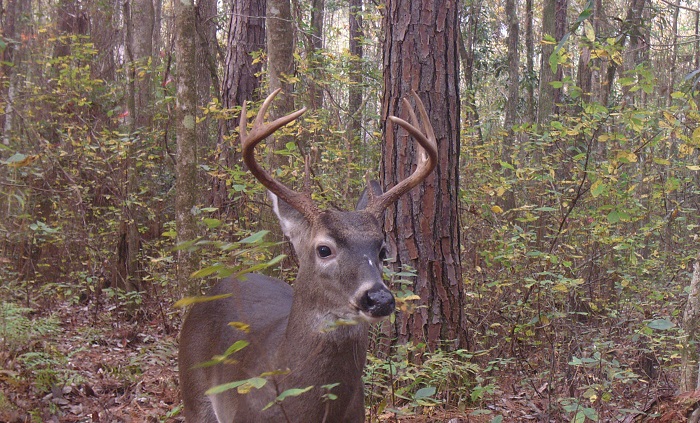
by Mark Mauldin | Nov 8, 2019

There are new regulations this season involving mandatory reporting of all deer harvested in Florida.
Photo Credit: Mark Mauldin
Deer hunting season here in Northwest Florida officially started this past Saturday (10/26) with the opening of archery and crossbow season; muzzleloading and general gun season will both open later this month. If you are fortunate enough to find success hunting in the woods, it is important that you remember substantial changes have gone into effect regarding the mandatory reporting of harvested deer. The following is a only a summary of some of the new regulations – complete official hunting regulations are available from the Florida Fish and Wildlife Conservation Commission.
The primary new regulation, put as simply as possible (again, this is only a summary):
All hunters must log their harvested deer prior to moving it from the point of harvest and report their harvested deer within 24 hours.
A hunter may log a harvested deer on a paper 2019-2020 Deer Harvest Log or via the FWC Deer Harvest Reporting App. The app allows a hunter to log and report a harvested deer, completing the process. If a hunter logs a deer on the paper form, they must also report the deer by calling 844-392-DEER (3337) between 8 a.m. – 8 p.m. ET or reporting online at MyFWC.com/HarvestReport. When successfully completed, either of these options, calling or going online, will result in a confirmation number. The confirmation number must be recorded on the Deer Harvest Log for the process to be complete. Note: using the app also generates a confirmation number that is automatically saved in the “sent” folder within the app. Follow the link for step-by-step instructions for using the FWC Deer Harvest Reporting App.
-
All harvested deer must be logged (on paper form or with the app) prior to being moved from where they were originally found.
-
All harvested deer must be reported (phone, online, or app) and confirmation number recorded on the paper log (or automatically on the app) within 24 hours of harvest**.
**Hunters must report harvested deer: 1) within 24 hours of harvest, or 2) prior to final processing of the deer, or 3) prior to the deer or any parts of the deer being transferred to a meat processor or taxidermist, or 4) prior to the deer leaving the state, whichever occurs first.
Hunters should be prepared to log and report harvested deer before they go hunting. They should have a copy of the 2019-2020 Deer Harvest Log with them, or have the FWC Deer Harvest Reporting App installed on their mobile device. In order to successfully log and report a harvested deer the hunter will also need the following information:
- Name (first and last name of the person who harvested the deer)
- Date of birth
- FWC Customer ID number (CID)
- Date of harvest
- Time of harvest
- Public or private land
- County
- Deer management unit
- Wildlife management area (if applicable)
- Method of harvest
- Antlered or antlerless deer
- Number of antler points (if antlered deer was indicated)
- Antlerless male or female (if antlerless deer was indicated)
- For deer taken on private lands, whether a deer program permit was used (Antlerless Deer Program permit or Private Lands Deer Management Program permit)
- 6-digit Tag number (if a deer program permit was used)
Another change for this hunting season is the establishment of the annual statewide bag limit of 5 deer per person of which no more than 2 deer can be antlerless.

FWC Deer Harvest Reporting APP
https://myfwc.com/hunting/deer/harvest-report/?redirect=harvestreport

FWC Deer Harvest Reporting Log
https://myfwc.com/media/21998/deer-harvest-log.pdf
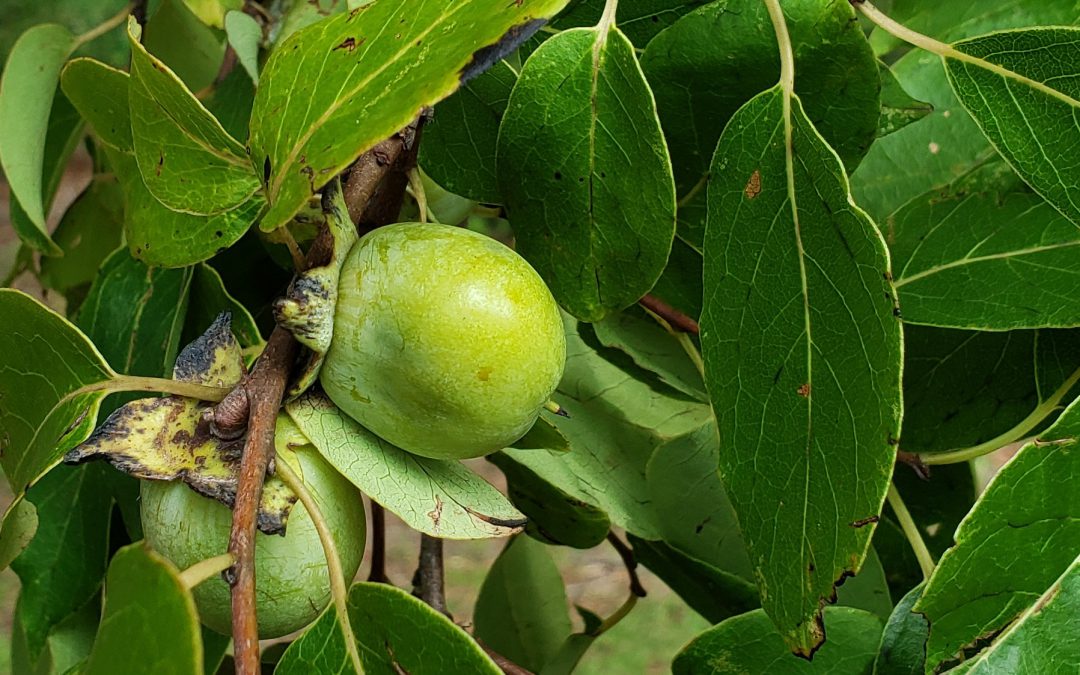
by Mark Mauldin | Oct 10, 2019
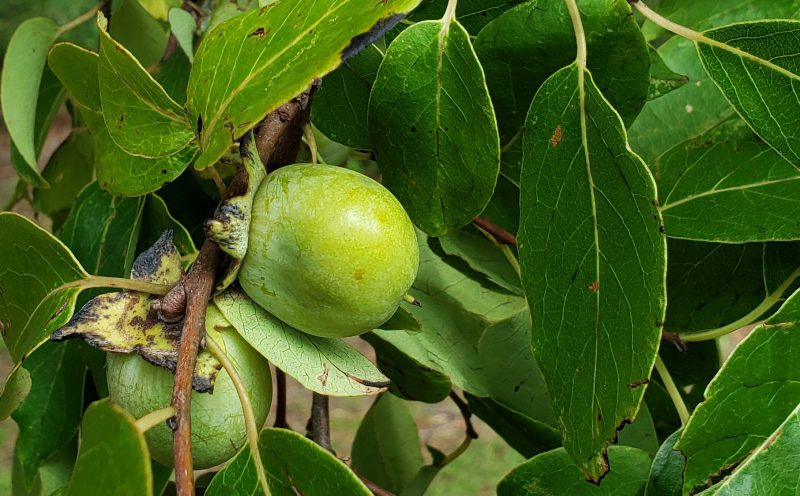
Protecting and promoting plants that produce soft mast, like this wild persimmon, can be a crucial step in improving wildlife habitat. Note: This time of year persimmons will be orange, the picture was taken earlier in the summer.
Photo Credit: Mark Mauldin
Landowners frequently prioritize wildlife abundance and diversity in their management goals. This is often related to a desired recreational activity (hunting, bird watching, etc.).
In order to successfully meet wildlife related management goals, landowners need to understand that animals frequent specific areas based largely on the quantity, quality and diversity of the food and cover resources available. Implementing management strategies that improve wildlife habitat will lead to greater wildlife abundance and diversity.
Herbivorous wildlife feed on plants, mostly in the form of forages and mast crops. All wildlife species have preferences in terms of habitat, especially food sources. Identifying these preferences and managing habitat to meet them will promote the abundance of the desired species.
Herbaceous plants, leaves, buds, etc. – serve as forages for many wildlife species. Promoting their growth and diversity is essential for improving wildlife habitat. Three common habitat management practices that promote forage growth include:
1) Create forest openings and edges; forested areas with multiple species and/or stand ages, areas left unforested allowing for increased herbaceous plant growth.
2) Thinning; open forest canopy allowing more light to hit the ground increasing herbaceous plant growth and diversity.
3) Prescribed fire; recycle nutrients, greatly improve the nutritional quality of herbage and browse, suppress woody understory growth.
Mast – the seeds and fruits of trees and shrubs – is often one of the most important wildlife food sources on a property.
Hard mast includes shelled seeds, like acorns and hickory nuts and is generally produced in the fall and serves as a wildlife food source during the winter.
Soft mast includes fruits, like blackberries and persimmons, and is generally produced in the warmer months, providing vital nutrition when wildlife species are reproducing and/or migrating.
Making management decisions that protect and promote mast producing trees will encourage wildlife populations.
Landowners can make supplemental plantings to increase the quantity and quality of the nutrition available to wildlife. These supplemental plantings (food plots/forage crops and mast producing trees) can be quite expensive and should be well planned to help maximize the return on investment.
Key points to remember to help ensure the success of supplemental wildlife plantings.
- Select species/varieties that are well adapted to the site.
- Take soil samples and make recommended soil amendments prior to planting.
- Make plantings in areas already frequented by wildlife (edges, openings, etc.).
- Food plots should be between 1 and 5 acres. Long, narrow designs that maximize proximity to cover are generally more effective.
Habitat management and other wildlife related topics are being featured this year in the UF/IFAS building at the Sunbelt Ag Expo. Make plans to attend “North America’s Premiere Farm Show” and stop by the UF/IFAS building, get some peanuts and orange juice and learn more about Florida’s Wildlife.
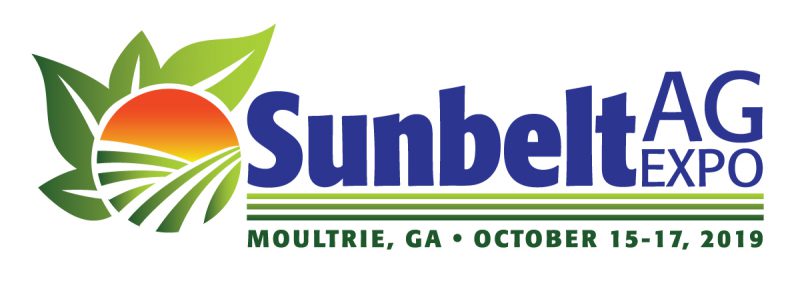 If you have any questions about the topics mentioned above, contact your county’s UF/IFAS Extension Office or check out the additional articles listed on the page linked below.
If you have any questions about the topics mentioned above, contact your county’s UF/IFAS Extension Office or check out the additional articles listed on the page linked below.
EDIS – Wildlife Forages
A significant portion of this article was summarized from Establishing and Maintaining Wildlife Food Sources by Chris Demers et al.
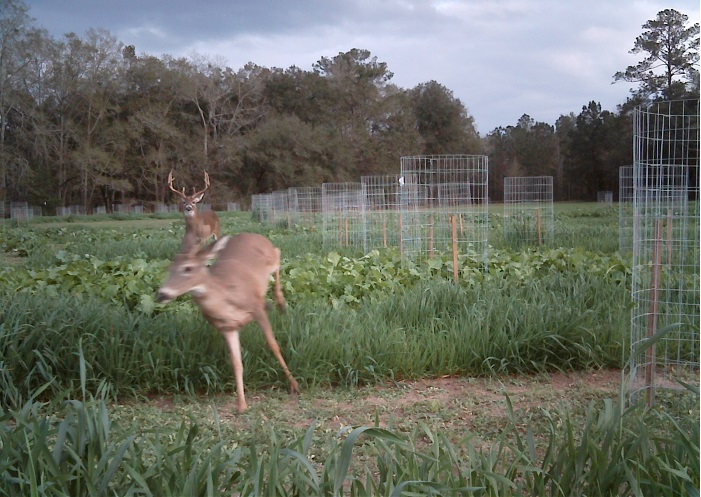
by Mark Mauldin | Sep 2, 2018

A buck chases a doe through plots of wildlife forages being evaluated at the University of Florida’s North Florida Research and Education Center. Photo Courtesy of Holly Ober
I know it feels too hot outside to talk about hunting season or cool-season food plots, but planting time will be here before you know it and now’s the time to start preparing. The recommended planting date for practically all cool-season forage crops in Northwest Florida is October 1 – November 15. Assuming adequate soil moisture, planting during the first half of the range is preferred. Between now and planting time there are several factors that need to be considered and addressed.
Invasive and/or Perennial Weed Control – Deer and other wildlife species utilize many soft/annual “weeds” as forage so controlling them is usually not a major concern. But from time to time unwanted perennials (grasses and woody shrubs) need to be controlled. An unfortunate and all too common example of and unwanted perennial is cogongrass – a highly invasive grass that should always be controlled if found. Effective control of perennial weeds, like cogongrass generally involves the use of herbicides. Late summer/early fall is a very effective time to treat unwanted perennials. Fortunately, this coincides well with the transition between warm-season and cool-season forages. If you have unwanted, perennial weeds in your food plots get them identified now and controlled before you plant your cool-season forages.
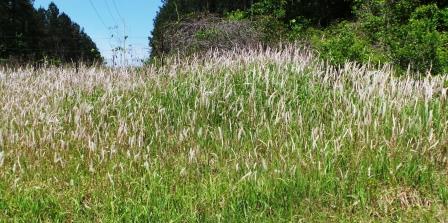
Cogongrass shown here with seedheads – more typically seen in the spring. If you suspect you have cogongrass in or around your food plots please consult your UF/IFAS Extension Agent how control options.
Photo credit: Mark Mauldin
Soil Fertility Management – In my experience, the most common cause for poor plant performance in food plots is inadequate soil fertility. Before planting time collect and submit soil samples from each of your food plots. Laboratory analysis of the samples will let you know the fertilizer and lime requirements of the upcoming cool-season crop. It is very important to have the analysis performed prior to planting so performance hindering issues can be prevented. Otherwise, during the growing season, by the time you realize something is wrong, it will likely be too late to effectively address the problem. This is particularly true if the issue is related to soil pH. To affect soil pH in a timely manner lime needs to be incorporated into the soil. Incorporation is impossible after the new crop has been planted. Soil analysis performed at the University of Florida’s Extension Soil Testing Lab cost $7 per sample. Your county’s UF/IFAS Extension Agent can assist you with the collection and submission process as well as help you interpret the results.
Variety Selection & Seed Sourcing – Sometimes it takes some time to find the best products/varieties. Just because forage seeds are sold locally doesn’t mean that the crop or specific variety is well suited to this area. The high temperatures and disease pressure associated with Florida, even in the “cool-season” mean that many products that do very well in other parts of the country may struggle here. Below are some specific forages that are favored by wildlife (specifically white-tailed deer) and generally well adapted to Florida. You may discover that these varieties are not sitting on the shelf at the local feed & seed. Often local suppliers can get specific varieties, but they must be special ordered, which adds time to the process. Hence the need to start planning and sourcing seed early.
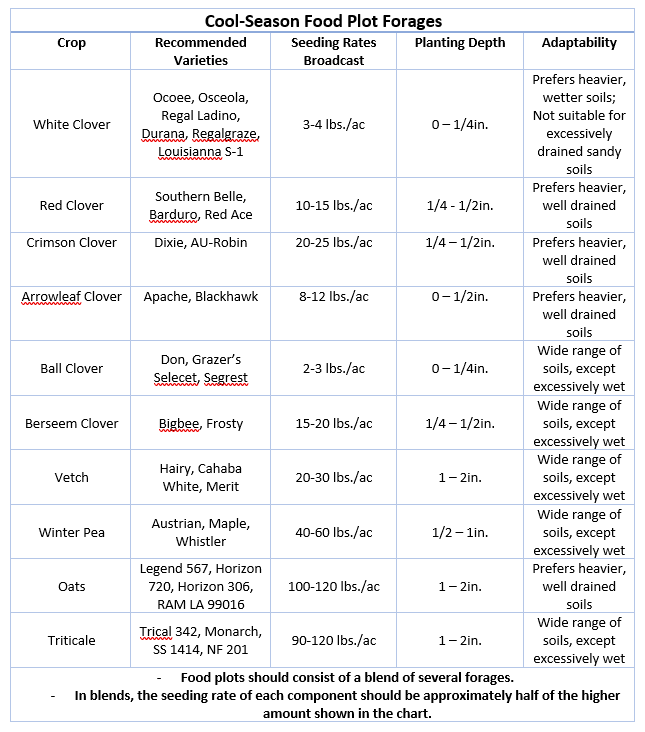
If you are debating trying food plots on your property for the first time, please carefully consider the following. Food plots are not easy – Making productive food plots that provide a measurable, positive impact to the wildlife on your property takes considerable time, effort, and money. Considering this, food plots really only make sense when viewed as habitat improvements that provide long term benefits to multiple wildlife species. If you are looking for nothing more than a deer attractant during hunting season food plots are not a very practical option. For more information on getting started with food plots contact your county’s UF/IFAS Extension Office and check out the reference below.
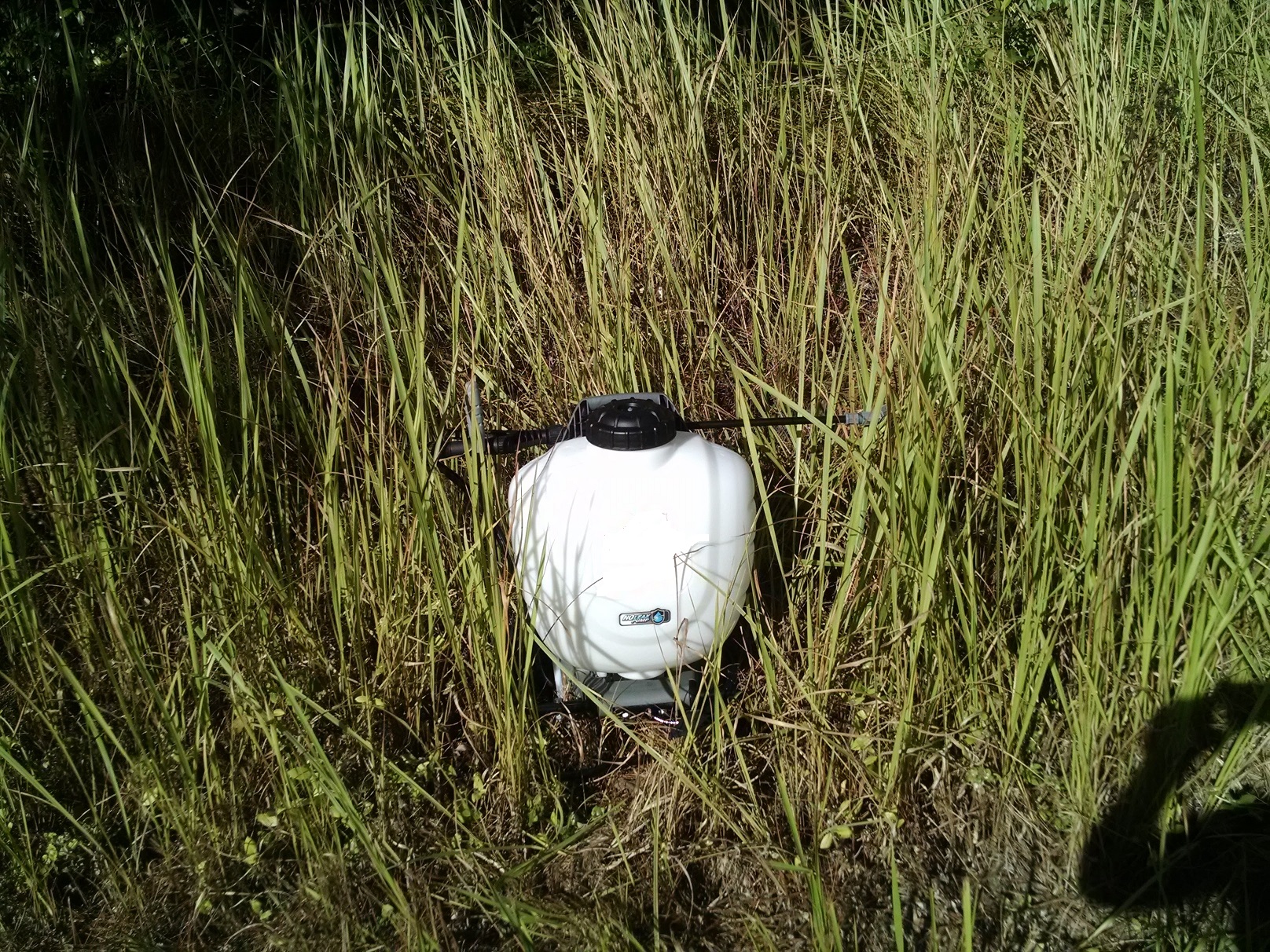
by Mark Mauldin | Mar 1, 2018
Chemical (Herbicide) treatments, while not the only option, are often required for effective control of woody invasive species. When treating woody invasive species there are three common, relatively simple techniques for applying herbicide; Foliar, Basal, and Cut Stump.
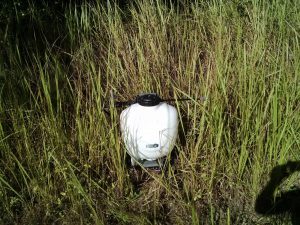
Foliar applications are the only option for invasive grasses like cogongrass. Photo Credit: Jennifer Bearden
Foliar Applications – spray solution is applied directly to leaves. For these applications to be effective leaves must be present and actively growing. Additionally, plants should not be disturbed for several weeks after the application. The herbicide must have time to move throughout the entire plant. Remember, the goal is killing plants, not leaves. Perennial plants can handle losing their leaves; they go through that process every year.
There are some points to consider when making foliar applications. The height of the plants being treated should not exceed 6-8ft. As the height of the plants increase, spray drift management becomes more of a concern. Upward spraying of herbicide greatly increases the likelihood of injuring non-target plants. Adequate coverage is another important consideration for foliar applications. All leaves need to be covered but not to the point of runoff. The timing of the application is also important; foliar sprays on perennial plants are generally the most effective in the late summer – early fall when the plants are naturally translocating product into their roots preparing for winter dormancy. This process facilitates the movement of herbicide into the roots.
Foliar applications are the only option for invasive grasses, they can be effective on shrubs, but are less than ideal for trees. The ratio of leaf area to total biomass is key to the effectiveness of foliar treatments; grasses are nearly all leaf, shrubs are relatively small and generally fairly leafy, trees can be very large with relatively few leaves making effective foliar treatments rather difficult. Retreatment is often needed to acquire complete control of trees and large shrubs.
As the name implies, individual plant treatments treat one plant at a time. These treatments are very effective, selective, and labor intensive. The two most straightforward kinds of individual plant treatment are basal and cut-stump applications.
Simply put, basal treatments involve applying an herbicide mixed with an oil penetrant directly to the bottom 12-18 inches of a standing tree or shrub. For basal treatments to be consistently effective trees need to be less than 6 inches in diameter and have smooth bark. Additionally, the bottom 12-18 inches of the stem need to be completely coated with herbicide/oil mixture. Results are very slow, often months. Basal treatments can be successful any time of year except during the “spring flush” when the upward sap flow impedes herbicide translocation. It should be noted that basal treatments will result in standing, dead trees and shrubs.
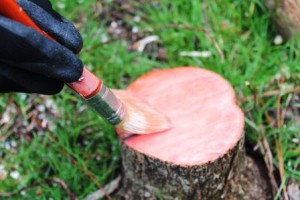
Cut stump treatment of removed tree prevents regrowth and is often used when controlling invasive species.
Cut-stump treatments involve applying a high concentration of herbicide directly to the freshly cut stump of an unwanted tree or shrub. The herbicide application prevents regrowth and suckering. These treatments are highly dependable and effective any time of year other than during the “spring flush”, as described above. For larger, thicker barked trees cut –stump treatments are the most dependable control option.
Follow the link below for additional information and for specific chemical recommendations to use with an of these techniques contact your county’s UF/IFAS Extension Office: Herbicide Techniques for Woody Plant Control
















